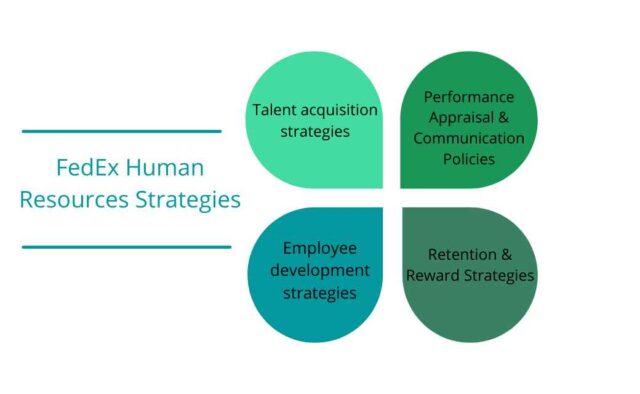Background Of FedEx
FedEx human resources strategies and their work as the subset of the whole management facilitated by the company, therefore, let’s understand the background of FedEx.
In 1973 FedEx started its services in 25 cities with 389 employees and 14 Dassault Falcon aircraft fleets.

Since the size of planes were small, they used to collect the packages at night from airports. Afterwards, they are brought to Memphis, where they get sorted. Later, they were flown to their subsequent airports and delivered by FedEx trucks the following morning. Which is proven to be a costly idea. Because of this initiative, the company lost $29 million in the first 26 months. A big amount was invested in physical transportation and infrastructure.
Afterwards, the HR policies are designed and practised in such a way as to overcome teething troubles and financial difficulties in the initial years. And focused on inspiring and motivating the employees to deliver the packages on time.
FedEx Human Resources Strategies
FedEx human resources are one of the first formal human resource strategies which viewed the employees as the reason for the organization’s growth and profitability. And, to achieve such growth, they opted for strategies such as:

Talent acquisition strategies
- Since FedEx was a new venture, it was difficult for a company to hire talented employees. The company was looking for employees with enthusiasm, drive and the ability to take risks.
- And to get the best talent into the company, FedEx human resources decided to offer stock options to create an environment full of exciting opportunities.
- And when the company picked up the growth speed and scaled up the operations, they were looking for 25,000+ candidates almost every day.
- Which forces the company to visit leading campuses located in different countries.
- Afterwards, FedEx human resources automated the job applications and screening process in 2001. Which encouraged the candidates to apply for different levels of jobs and according to their skill set.
- Accordingly, there were several opportunities at various levels and in different departments like operations, maintenance, customer service, administrative support, customer service, IT, Sales, HR etc.
- Moreover, FedEx human resources created internship opportunities for college students to create enthusiasm for a company.
- To hire the correct candidates, their profile is matched with an online database called Personnel Records Information System (PRISM) which identifies eligible candidates.
- Then, they were required to take an aptitude test and then the interview process began. Only the successful candidates are required to give a fitness test, reference checking, etc before being offered a job at FedEx.
- PRISM is proven as a great help to provide appropriate job seekers, who have appropriate skill sets from different locations.
Performance Appraisal And Communication Policies
- FedEx human resources encourage its employees to participate in the Survey-Feedback-Action(SAF) program.
- Which was initially conducted manually but later changed to an online survey.
- SAF is conducted to examine employee satisfaction which is examined to identify the problems within and outside the department.
- It helped the employees to provide feedback about their managers, supervisors, HR policies etc anonymously.
- Afterwards, the results of SAF are analysed and calculated to obtain a company-wide leadership score(CLS).
- CLS is used in FedEx human resources for granting promotions, rewards, incentives etc. Plus the managers whose score does not improve from previous years were not granted the annual bonus.
- Such activities in FedEx helped in gaining continuous improvement, rapid growth and syncing with changing market trends.
- On the other hand, non-managerial employees’ performance parameters are customer orientation, ability to get along with team members, technical competencies, loyalty etc.
- In the end, FedEx human resources create performance appraisal will depend upon people, service and profits.
- And, any major event in FedEx was informed to the employees through an in house satellite cable network called FXTV.
Employee development strategies

- New employees go under an orientation program where the company’s philosophy, norms, procedures and practices etc are explained by FedEx human resources.
- Apart from these employees are encouraged to build and maintain healthy relations with their customers and colleagues.
- Job testing programs are designed to evaluate the proficiency of employees while working.
- These tests are conducted by PRISM which is compulsory for every employee to clear.
- And those who were unable to clear the exam have to undergo training at regular intervals. FedEx human resources have created a Leadership Development Institute to fulfil all the requirements of managerial personnel in the mid-1980s.
- In 1995 FedEx has tied up with the Christian Brothers University and 40 weeks training course to impart IT and managerial skills and training to its US employees.
- Another test called LEAP mid-1980swas conducted to test leadership capabilities. Which encouraged more than 3000 employees every year to take tests and to become eligible for the promotion.
- Lastly, for temporary employees who were paid on an hourly basis, Job Change Applicant Tracking System‟ (JCATS) were introduced on which vacant positions were posted every Friday. It is provided permanent job opportunities for temporary employees.
- By the late 1990s FedEx human resources introduced a program Succession Planning Executive Education (SPEED). Which enables employees to take automated, internet-enabled skill assessments over a while. To help employees to slip into senior management.
Retention & Reward Strategies
- FedEx human resources do everything for employee retention, whenever any employee tries to quit the company collect feedback through exit interviews. Employees leaving the organization were asked to explain the reasons behind quitting and whether they will be interested in joining the organization if some opportunity is given.
- This information is collected and posted on PRISM to analyse employee retention.
- Also, the employees are given regards, awards and recognition for delivering high values to customers on individual and group levels.
- One such program created by FedEx human resources was known as „jump seating’ that allowed employees to fly free of cost to any location where FedEx aircrafts operated.
Conclusion
In the area of package and freight transportation, FedEx reached the top of the summit very early in its life. It was all because of its people-friendly policies. Its philosophy of creating FedEx human resources and putting people first paid handsome dividends in course of time helped the company to top the list of Fortune “100 Best Companies to Work For in 10 of the past 11 years. It also figured in Fortune‟s list of “World‟s Most Admired Companies”.